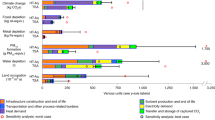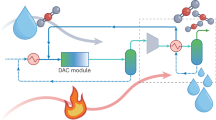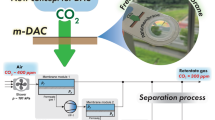Abstract
Current climate targets require negative carbon dioxide (CO2) emissions. Direct air capture is a promising negative emission technology, but energy and material demands lead to trade-offs with indirect emissions and other environmental impacts. Here, we show by life-cycle assessment that the commercial direct air capture plants in Hinwil and Hellisheiði operated by Climeworks can already achieve negative emissions today, with carbon capture efficiencies of 85.4% and 93.1%. The climate benefits of direct air capture, however, depend strongly on the energy source. When using low-carbon energy, as in Hellisheiði, adsorbent choice and plant construction become more important, inducing up to 45 and 15 gCO2e per kilogram CO2 captured, respectively. Large-scale deployment of direct air capture for 1% of the global annual CO2 emissions would not be limited by material and energy availability. However, the current small-scale production of amines for the adsorbent would need to be scaled up by more than an order of magnitude. Other environmental impacts would increase by less than 0.057% when using wind power and by up to 0.30% for the global electricity mix forecasted for 2050. Energy source and efficiency are essential for direct air capture to enable both negative emissions and low-carbon fuels.
This is a preview of subscription content, access via your institution
Access options
Access Nature and 54 other Nature Portfolio journals
Get Nature+, our best-value online-access subscription
$29.99 / 30 days
cancel any time
Subscribe to this journal
Receive 12 digital issues and online access to articles
$119.00 per year
only $9.92 per issue
Buy this article
- Purchase on Springer Link
- Instant access to full article PDF
Prices may be subject to local taxes which are calculated during checkout







Similar content being viewed by others
Data availability
Data on the LCI, the studied scenarios and the resulting environmental impacts are available within this paper and the Supplementary Information. More details on the datasets generated and/or analysed during the current study are not publicly available since they contain commercially relevant information from Climeworks, but are available from the corresponding author on reasonable request and with permission of Climeworks.
References
Tollefson, J. The hard truths of climate change — by the numbers. A set of troubling charts shows how little progress nations have made toward limiting greenhouse-gas emissions. Nature https://doi.org/10.1038/d41586-019-02711-4 (2019).
Le Quéré, C. et al. Temporary reduction in daily global CO2 emissions during the COVID-19 forced confinement. Nat. Clim. Change, 10 647–653 (2020).
Report of the Conference of the Parties on its Twenty-First Session Decision 1/CP.21 (United Nations Framework Convention on Climate Change, 2015).
IPCC Special Report on Global Warming of 1.5 °C (eds Masson-Delmotte, V. et al.) (WMO, 2018).
Rogelj, J. et al. Scenarios towards limiting global mean temperature increase below 1.5 °C. Nat. Clim. Change 8, 325–332 (2018).
Goglio, P. et al. Advances and challenges of life cycle assessment (LCA) of greenhouse gas removal technologies to fight climate changes. J. Clean. Prod. 244, 118896 (2020).
Brethomé, F. M., Williams, N. J., Seipp, C. A., Kidder, M. K. & Custelcean, R. Direct air capture of CO2 via aqueous-phase absorption and crystalline-phase release using concentrated solar power. Nat. Energy 3, 553–559 (2018).
Socolow, R. et al. Direct Air Capture of CO2 with Chemicals. A Technology Assessment for the APS Panel on Public Affairs (American Physical Society, 2011).
Gunnarsson, I. et al. The rapid and cost-effective capture and subsurface mineral storage of carbon and sulfur at the CarbFix2 site. Int. J. Greenh. Gas. Con. 79, 117–126 (2018).
Matter, J. M. et al. Rapid carbon mineralization for permanent disposal of anthropogenic carbon dioxide emissions. Science 352, 1312–1314 (2016).
Deutz, S. et al. Cleaner production of cleaner fuels: wind-to-wheel – environmental assessment of CO2-based oxymethylene ether as a drop-in fuel. Energy Environ. Sci. 11, 331–343 (2018).
Liu, C. M., Sandhu, N. K., McCoy, S. T. & Bergerson, J. A. A life cycle assessment of greenhouse gas emissions from direct air capture and Fischer–Tropsch fuel production. Sustain. Energy Fuels 4, 3129–3142 (2020).
Artz, J. et al. Sustainable conversion of carbon dioxide: an integrated review of catalysis and life cycle assessment. Chem. Rev. 118, 434–504 (2018).
Kätelhön, A., Meys, R., Deutz, S., Suh, S. & Bardow, A. Climate change mitigation potential of carbon capture and utilization in the chemical industry. Proc. Natl Acad. Sci. USA 116, 11187–11194 (2019).
Ostovari, H., Sternberg, A. & Bardow, A. Rock ‘n’ use of CO2: carbon footprint of carbon capture and utilization by mineralization. Sustain. Energy Fuels 4, 4482–4496 (2020).
Nduagu, E., Bergerson, J. & Zevenhoven, R. Life cycle assessment of CO2 sequestration in magnesium silicate rock – a comparative study. Energy Convers. Manag. 55, 116–126 (2012).
Smit, B., Reimer, J. A., Oldenburg, C. M. & Bourg, I. C. Introduction to Carbon Capture and Sequestration (Imperial College Press, 2014).
Sanz-Pérez, E. S., Murdock, C. R., Didas, S. A. & Jones, C. W. Direct capture of CO2 from ambient air. Chem. Rev. 116, 11840–11876 (2016).
McQueen, N. et al. Cost analysis of direct air capture and sequestration coupled to low-carbon thermal energy in the United States. Environ. Sci. Technol. 54, 7542–7551 (2020).
Nikulshina, V., Gálvez, M. E. & Steinfeld, A. Kinetic analysis of the carbonation reactions for the capture of CO2 from air via the Ca(OH)2–CaCO3–CaO solar thermochemical cycle. Chem. Eng. J. 129, 75–83 (2007).
Nikulshina, V., Gebald, C. & Steinfeld, A. CO2 capture from atmospheric air via consecutive CaO-carbonation and CaCO3-calcination cycles in a fluidized-bed solar reactor. Chem. Eng. J. 146, 244–248 (2009).
Azarabadi, H. & Lackner, K. S. A sorbent-focused techno-economic analysis of direct air capture. Appl. Energy 250, 959–975 (2019).
Chaikittisilp, W., Kim, H.-J. & Jones, C. W. Mesoporous alumina-supported amines as potential steam-stable adsorbents for capturing CO2 from simulated flue gas and ambient air. Energ. Fuel 25, 5528–5537 (2011).
Gebald, C., Wurzbacher, J. A., Borgschulte, A., Zimmermann, T. & Steinfeld, A. Single-component and binary CO2 and H2O adsorption of amine-functionalized cellulose. Environ. Sci. Technol. 48, 2497–2504 (2014).
Gebald, C., Wurzbacher, J. A., Tingaut, P. & Steinfeld, A. Stability of amine-functionalized cellulose during temperature-vacuum-swing cycling for CO2 capture from air. Environ. Sci. Technol. 47, 10063–10070 (2013).
Gebald, C., Wurzbacher, J. A., Tingaut, P., Zimmermann, T. & Steinfeld, A. Amine-based nanofibrillated cellulose as adsorbent for CO2 capture from air. Environ. Sci. Technol. 45, 9101–9108 (2011).
McDonald, T. M. et al. Cooperative insertion of CO2 in diamine-appended metal-organic frameworks. Nature 519, 303–308 (2015).
Keith, D. W., Holmes, G., St. Angelo, D. & Heidel, K. A process for capturing CO2 from the atmosphere. Joule 2, 1573–1594 (2018).
de Jonge, M. M. J., Daemen, J., Loriaux, J. M., Steinmann, Z. J. N. & Huijbregts, M. A. J. Life cycle carbon efficiency of direct air capture systems with strong hydroxide sorbents. Int. J. Greenh. Gas. Con. 80, 25–31 (2019).
Goeppert, A., Czaun, M., Surya Prakash, G. K. & Olah, G. A. Air as the renewable carbon source of the future: an overview of CO2 capture from the atmosphere. Energy Environ. Sci. 5, 7833–7853 (2012).
Wurzbacher, J. A., Gebald, C. & Steinfeld, A. Separation of CO2 from air by temperature-vacuum swing adsorption using diamine-functionalized silica gel. Energy Environ. Sci. 4, 3584–3592 (2011).
Fasihi, M., Efimova, O. & Breyer, C. Techno-economic assessment of CO2 direct air capture plants. J. Clean. Prod. 224, 957–980 (2019).
Wurzbacher, J. A., Gebald, C., Brunner, S. & Steinfeld, A. Heat and mass transfer of temperature–vacuum swing desorption for CO2 capture from air. Chem. Eng. J. 283, 1329–1338 (2016).
Wurzbacher, J. A., Gebald, C., Piatkowski, N. & Steinfeld, A. Concurrent separation of CO2 and H2O from air by a temperature-vacuum swing adsorption/desorption cycle. Environ. Sci. Technol. 46, 9191–9198 (2012).
Stuckert, N. R. & Yang, R. T. CO2 capture from the atmosphere and simultaneous concentration using zeolites and amine-grafted SBA-15. Environ. Sci. Technol. 45, 10257–10264 (2011).
van der Giesen, C. et al. A life cycle assessment case study of coal-fired electricity generation with humidity swing direct air capture of CO2 versus MEA-based postcombustion capture. Environ. Sci. Technol. 51, 1024–1034 (2017).
Zhang, X., Bauer, C., Mutel, C. L. & Volkart, K. Life cycle assessment of power-to-gas: approaches, system variations and their environmental implications. Appl. Energy 190, 326–338 (2017).
Fuhrman, J. et al. Food–energy–water implications of negative emissions technologies in a +1.5 °C future. Nat. Clim. Change 10, 920–927 (2020).
Chatterjee, S. & Huang, K.-W. Unrealistic energy and materials requirement for direct air capture in deep mitigation pathways. Nat. Commun. 11, 3287 (2020).
Realmonte, G. et al. Reply to “High energy and materials requirement for direct air capture calls for further analysis and R&D”. Nat. Commun. 11, 3286 (2020).
Realmonte, G. et al. An inter-model assessment of the role of direct air capture in deep mitigation pathways. Nat. Commun. 10, 3277 (2019).
ISO 14040:2006. Environmental Management — Life Cycle Assessment — Principles and Framework (International Organization for Standardization, 2006).
ISO 14044:2006. Environmental Management — Life Cycle Assessment — Requirements and Guidelines (International Organization for Standardization, 2006).
Climeworks Raises CHF 30.5M (USD 30.8M) to Commercialize Carbon Dioxide Removal Technology Press release (Climeworks, 2018).
Sternberg, A. & Bardow, A. Power-to-What? – Environmental assessment of energy storage systems. Energy Environ. Sci. 8, 389–400 (2015).
Global Land Outlook 1st edn (United Nations Convention to Combat Desertification, 2017).
Negative Emissions Technologies and Reliable Sequestration: a Research Agenda (National Academies of Sciences, Engineering, and Medicine, 2019).
The International Reference Life Cycle Data System (ILCD) Handbook - General Guide for Life Cycle Assessment - Detailed Guidance (Publications Office of the European Union, 2010).
Tanzer, S. E. & Ramírez, A. When are negative emissions negative emissions? Energy Environ. Sci. 12, 1210–1218 (2019).
Müller, L. J. et al. A guideline for life cycle assessment of carbon capture and utilization. Front. Energy Res. https://doi.org/10.3389/fenrg.2020.00015 (2020).
Lee, S.-Y. & Park, S.-J. A review on solid adsorbents for carbon dioxide capture. J. Ind. Eng. Chem. 23, 1–11 (2015).
Sala, S., Crenna, E., Secchi, M. & Pant, R. Global Normalisation Factors for the Environmental Footprint and Life Cycle Assessment (Publications Office of the European Union, 2017).
GaBi 9.2.0.58: Software-System and Database for Life Cycle Engineering, DB 8.7 - SP 39 (thinkstep AG, 2019).
ecoinvent data version 3.5, cut-off (Swiss Centre for Life Cycle Inventories, 2019).
Product Environmental Footprint Category Rules Guidance version 6.3 – May 2018 (European Commission, 2018).
International Reference Life Cycle Data System (ILCD) Handbook - Recommendations for Life Cycle Impact Assessment in the European Context from the European Commission. (Publications Office of the European Union, 2011).
Supporting Information to the Characterisation Factors of Recommended EF Life Cycle Impact Assessment Methods: New Methods and Differences with ILCD (Publications Office of the European Union, 2018).
Wegener Sleeswijk, A., van Oers, L. F. C. M., Guinée, J. B., Struijs, J. & Huijbregts, M. A. J. Normalisation in product life cycle assessment: an LCA of the global and European economic systems in the year 2000. Sci. Total Environ. 390, 227–240 (2008).
Crenna, E., Secchi, M., Benini, L. & Sala, S. Global environmental impacts: data sources and methodological choices for calculating normalization factors for LCA. Int. J. LCA 24, 1851–1877 (2019).
Pizzol, M. et al. Normalisation and weighting in life cycle assessment: quo vadis? Int. J. LCA 22, 853–866 (2017).
Energy Technology Perspectives 2017: Catalysing Energy Technology Transformations (International Energy Agency, 2017).
Esen, H., Inalli, M., Esen, M. & Pihtili, K. Energy and exergy analysis of a ground-coupled heat pump system with two horizontal ground heat exchangers. Build. Environ. 42, 3606–3615 (2007).
Ozgener, O. & Hepbasli, A. Experimental performance analysis of a solar assisted ground-source heat pump greenhouse heating system. Energ. Build. 37, 101–110 (2005).
Averfalk, H., Ingvarsson, P., Persson, U., Gong, M. & Werner, S. Large heat pumps in Swedish district heating systems. Renew. Sust. Energ. Rev. 79, 1275–1284 (2017).
David, A., Mathiesen, B. V., Averfalk, H., Werner, S. & Lund, H. Heat roadmap Europe: large-scale electric heat pumps in district heating systems. Energies 10, 578 (2017).
Karlsdóttir, M. R., Palsson, O. P. & Palsson, H. LCA of combined heat and power production at Hellisheiði geothermal power plant with focus on primary energy efficiency. In Proc. 12th International Symposium on District Heating and Cooling (Tallinna Tehnikaülikool, Nordic Energy Research and norden, 2010).
Karlsdóttir, M. R., Pálsson, Ó. P., Pálsson, H. & Maya-Drysdale, L. Life cycle inventory of a flash geothermal combined heat and power plant located in Iceland. Int. J. LCA 20, 503–519 (2015).
Ekvall, T. & Weidema, B. P. System boundaries and input data in consequential life cycle inventory analysis. Int. J. LCA 9, 161–171 (2004).
Sternberg, A. & Bardow, A. Life cycle assessment of power-to-gas: syngas vs methane. ACS Sustain. Chem. Eng. 4, 4156–4165 (2016).
Götz, M. et al. Renewable power-to-gas: a technological and economic review. Renew. Energy 85, 1371–1390 (2016).
Sternberg, A., Jens, C. M. & Bardow, A. Life cycle assessment of CO2-based C1-chemicals. Green Chem. 19, 2244–2259 (2017).
Bongartz, D. et al. Comparison of light-duty transportation fuels produced from renewable hydrogen and green carbon dioxide. Appl. Energy 231, 757–767 (2018).
Cuéllar-Franca, R. M. & Azapagic, A. Carbon capture, storage and utilisation technologies: a critical analysis and comparison of their life cycle environmental impacts. J. CO2 Util. 9, 82–102 (2015).
Boot-Handford, M. E. et al. Carbon capture and storage update. Energy Environ. Sci. 7, 130–189 (2014).
Koornneef, J., van Keulen, T., Faaij, A. & Turkenburg, W. Life cycle assessment of a pulverized coal power plant with post-combustion capture, transport and storage of CO2. Int. J. Greenh. Gas. Con. 2, 448–467 (2008).
Pehnt, M. & Henkel, J. Life cycle assessment of carbon dioxide capture and storage from lignite power plants. Int. J. Greenh. Gas. Con. 3, 49–66 (2009).
Clark, D. E. et al. CarbFix2: CO2 and H2S mineralization during 3.5 years of continuous injection into basaltic rocks at more than 250 °C. Geochim. Cosmochim. Acta 279, 45–66 (2020).
Global Energy & CO2 Status Report 2017 (International Energy Agency, 2018).
Acknowledgements
We gratefully acknowledge funding by the German Federal Ministry of Education and Research (BMBF) within the Kopernikus Project P2X: flexible use of renewable resources—exploration, validation and implementation of ‘Power-to-X’ concepts. In particular, we thank the Power-to-X project partner Climeworks who provided data, insight and expertise in their technology that greatly assisted our research as part of the publicly funded Kopernikus project Power-to-X. We thank L. Kroeger and K. Leonhard for the valuable discussions on reaction kinetics and thermochemistry, and D. Bongartz for conducting the process simulations on heat integration of DAC and synthetic fuel production. We further thank N. McQueen and J. Wilcox for comments helping us to improve our study, and V. Beckert, L. Dörpinghaus, N. Groll, F. Pellengahr and N. Tigu for their technical support.
Author information
Authors and Affiliations
Contributions
S.D. and A.B. designed and performed research, analysed data and wrote the paper.
Corresponding author
Ethics declarations
Competing interests
The authors declare no competing interests.
Additional information
Peer review information Nature Energy thanks Derrick Carlson and the other, anonymous, reviewer(s) for their contribution to the peer review of this work.
Publisher’s note Springer Nature remains neutral with regard to jurisdictional claims in published maps and institutional affiliations.
Supplementary information
Supplementary Information
Supplementary Notes 1–12, Figs. 1–51 and Tables 1–30.
Rights and permissions
About this article
Cite this article
Deutz, S., Bardow, A. Life-cycle assessment of an industrial direct air capture process based on temperature–vacuum swing adsorption. Nat Energy 6, 203–213 (2021). https://doi.org/10.1038/s41560-020-00771-9
Received:
Accepted:
Published:
Issue Date:
DOI: https://doi.org/10.1038/s41560-020-00771-9
This article is cited by
-
A taxonomy to map evidence on the co-benefits, challenges, and limits of carbon dioxide removal
Communications Earth & Environment (2024)
-
Redox-tunable isoindigos for electrochemically mediated carbon capture
Nature Communications (2024)
-
Co-assessment of costs and environmental impacts for off-grid direct air carbon capture and storage systems
Communications Engineering (2024)
-
An industrial take on developing and deploying carbon capture at scale
Nature Reviews Chemistry (2023)
-
Towards circular plastics within planetary boundaries
Nature Sustainability (2023)



